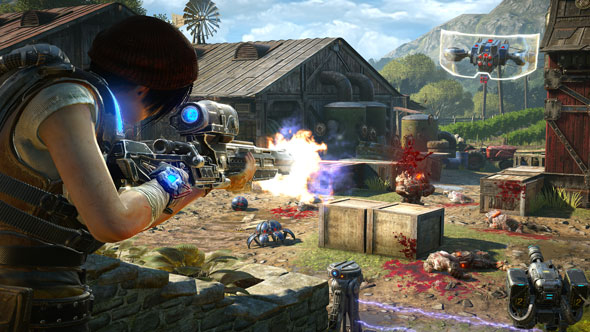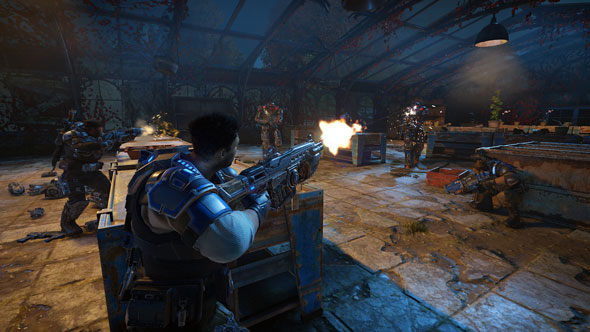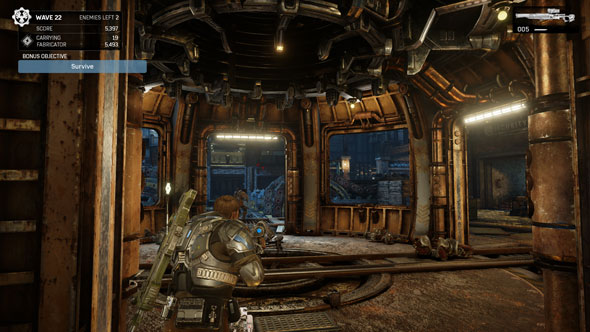I like to think that I’m too wizened and cynical to be easily wowed by spectacular, scripted set-pieces, massive explosions, and cinematic gameplay sequences that make me question whether I’m playing the game or just watching it. But Gears of War 4, which marks the return of the hulking Xbox 360 flagship franchise to the PC after a nine-year hiatus, has made me question all that.
Want an in-depth analysis of how the game performs on PC? Head over to our Gears of War 4 PC port review.
The campaign is spectacular. A visual and technical tour de force, it manages to maintain searing frame-rates on ‘ultra’ settings during some of the most mind-blowing – if cheesy – set-pieces I’ve seen in games, while also inviting me to appreciate the vivid redness of sycamore leaves lazily billowing on a cracked yellow wall in a medieval town square on some parallel-to-Earth planet. This certainly ain’t the grey-brown Gears of old. Combine that with the fact that it’s all playable split-screen on PC as if that’s the most normal thing in the world, I already have a ton of goodwill for Gears of War 4. And I haven’t even mentioned the multiplayer yet…
But let’s start at the beginning.
It’s 10 years since the COG fought off the Locust invasion, and the last remnants of humanity are split between those living within the walls of the overbearing COG government and Outsiders – people who choose to live beyond society’s politically confined confines. You are JD Fenix, the surprisingly (and generically) handsome son of surly, gorilla-like series icon, Marcus Fenix.
JD and his two pals, Kait and Del, are Outsiders whose village gets beset by a sort-of new alien scourge called The Swarm, who run off with Kait’s mother (and Outsider leader) Reyna, as well as her comic-relief, barrel-bellied Mexican uncle, Oscar. In need of help, the trio track down JD’s estranged dad Marcus – festering aloof in his rural manor like a futuristic Daniel Plainview. So Marcus, JD and pals gear up (sorry) and head off on an adventure that’s tonally an underdog story like the original game rather than the all-out warfare of the sequels.

The contrast between the new Gears characters and the old ones is striking, both in looks and writing. Where the old COGs had the aura of Viking Berserkers, heading into battle with a nothing-to-lose nihilism and old school camaraderie, JD, Del and Kait are all… well, a bit young and beautiful. I never settled into their dynamic for the long segments when Marcus isn’t around. Lines like “Worst. Museum. Ever” after a firefight in an abandoned museum, or Del and JD’s anodyne running joke where they argue about whether a given situation they’re in is ‘ironic’ is the kind of chat more befitting of a subreddit than a battlefield. I’m grateful for each moment that Marcus is there, grumbling in his ‘Kids these days’ manner to provide a nice, dour counterpoint to their jauntiness.
With that said, The devs at The Coalition make it clear that they want to attract a hip new audience rather than just continue appeasing the established old guard, so perhaps I’m just a fuddy-duddy and this is what the youth of today want.
Besides, the oftentimes bland filler banter is drowned out by a solid overarching story, which is essentially about JD and Kait reuniting with their parents against a backdrop of alien armageddon. The mechanics are pretty much classic Gears, as you sprint between bits of conveniently placed cover, trying to flank your enemies before they do it to you. The mechanics retain that weighty feel that’s only appropriate for characters wearing bulky refrigerator armour, but also maintain a degree of fluidity thanks to mobile moves like the dodge roll, the fly-kick over cover, and the Yank and Shank, which lets you pull enemies out from behind cover and execute them.

It’s none too complex, but still makes for some of the best third-person shooter gameplay around. The only area that leaves a bit to be desired here is the melee, which aside from the vicious Lancer chainsaw can lead to many moments of confused and blind gun-whipping that fails to match the flow of the rest of the battles.
For a game whose design is naturally vulnerable to becoming repetitive across a 12-15-hour single-player campaign, Gears 4 keeps things fresh with beautiful environments and a healthy smattering of gameplay-light set-pieces. The campaign gathers momentum well after you get past its slow start. The early battles with COG’s robotic police force aren’t terribly exciting (at the risk of sounding disturbed, I’ve always found it more satisfying sawing and shooting through flesh than through metal and cables), and not really boosted by the Windflares that were touted so much in the build-up to release (dodging between the lightning strikes is like a less precise version of Frogger). The motorcycle chase at the end of this Act, meanwhile, is pretty much a glorified Temple Run. Thankfully, things do pick up after this.

I’ve always been fascinated by Gears’ Earth-like setting, which teases us with a rich and deep history that the series only ever skimmed the surface of. Gears 4 doesn’t tell us much more (aside from Del’s goofy remarks about how they used to bury “Kings and Wizards” in the tombs – Shut Up, Del), but the diversity of what it shows is stunning. I’ve fought waves of agile, monkey-like Juvies in tombs containing great gold statues of ancient kings; I’ve witnessed DeeBees taking on the Swarm in the central squares of charming Alpine-but-not towns; and taken on the formidable new Pouncers in the rain-soaked courtyards of medieval castles. This is a far cry from the game that single-handedly started the stereotype of the ‘murky brown war shooter’, taking us instead on a historical tour of the vestiges of a world parallel to ours, yet still different enough to be mysterious; I almost felt guilty as I stomped around a scenic town as a giant mech, casually calling in airstrikes to smash my way through buildings. Almost.
Sequences display enough variety to allow you to engage with all kinds of heavy machinery. One standout shootout takes place in a room where what can best be described as giant bike chains slam down into the ground, providing ever-shifting cover, but also the danger of crushing you at any moment. The pinnacle of spectacle for me, however, was being pulled up at 100mph on a cable towards the giant burning gears (there’s a lot of coggy, geary imagery in this game) of an elevator. It was mechanically simple, but quite possibly the most jawdropping 60 seconds I’ve ever experienced in a game. With the hellish webbing of Swarm tendrils below me, girders and metal architecture crumbling and melting all around, and Juvies inexplicably hurtling towards me from above, it was a stunning sensory overload.
.jpg)
Despite my scepticism about these hip new heroes’ ability to wave the flag for the series going forward, the campaign is an incredible romp – occasionally repetitive, often breathtaking – framed in a simple but poignant story that you come to care about, and with enough throwbacks to keep Gears veterans happy.
But the real staying power of Gears of War 4 lies in its Horde and Competitive modes, which return with much the same mechanics series fans will remember, bolstered by better matchmaking to separate the skilled from me the not-so-skilled, and a selection of nine all-new maps (along with Gridlock – the de_dust of Gears of War). On top of this, two new maps will be released each month for the next year, and will be available for everyone to play on a rotating basis. It’s a welcoming, gamer-friendly setup compared to the ‘Buy the season pass or get left behind’ system of other big shooters (though if you want to host private matches on the additional maps, you’ll need to buy them or the season pass).
.jpg)
Horde – the classic wave survival mode – sees you pick one of several classes and attempt to hold off 50 waves of Swarm and DeeBees. If you’ve played Horde before, the main difference this time is the ability to place fortifications and defences anywhere on the map, encouraging you to experiment with each location and work out what the most defensible places are. Enemies drop tokens that you can use to buy and upgrade defences (which include turrets, sentries, decoys and fences), and extra goodies can be earned by achieving bonus objectives in each wave, such as by getting a certain number of headshots, or by everyone surviving a wave.
The maps are, at first glance, pretty boxy, and certainly don’t capture the majesty of some of the single-player backdrops I gushed over earlier. Maybe because of The Coalition’s ambitions to turn Gears 4 into an eSport, where balance and fairness is essential at all costs, the maps feel a bit stagey, a bit symmetrical for my liking; so symmetrical, in fact, that from top-down they look like particularly block Rorschach tests. In the map below, for instance, I see the Atari version of ET. How about you?

But explore these sprawling, largely horizontal spaces, and there’s more to them than meets the eye. During one Horde session on Forge, for example, I broke away from my squad’s defensive position around what can best be described as an industrial gazebo to get up onto a platform I’d spotted at a far point of the map. The position offered a view of a large portion of the battlefield, allowing me to merrily snipe enemies from behind as they attacked the group. Strangely, there was a big red switch on the platform, which I duly pressed like any intrepid gamer would, which caused the gazebo to turn into a giant incinerator, frazzling all enemies within it. So there are some meticulously positioned surprises on these seemingly predictable spaces.
The multiplayer mechanics are as crisp as you’d expect from a Gears game. Supporting Fire plays a key role as you dart from cover to cover trying to outfox and outflank your enemies, while the fly-over-cover kick and Yank & Shank provide extra tools for those looking to do the occasional death or glory charge headlong into their enemies. Executions are as grisly and satisfying as ever, while losing out in a Lancer duel where you and your opponent try to out-button-tap each other remains weirdly emasculating.

True to a game looking to play in the eSports big leagues, progression in the competitive multiplayer is typified by skins for your weapons and characters, which you can buy using credits earned in-game or using real-life money if you’re so inclined (so long as people can’t buy themselves advantages on the battlefield, it’s all good by me). Horde, meanwhile, has introduced a compelling little progressions system where you unlock cards containing various upgrades for each class, allowing you to really fine-tune your character to your play style.
Gears of War 4 epitomises the ‘Complete Package’ game. Its single-player campaign is simple but spectacular, and its multiplayer makes all the minor evolutions necessary to position it firmly among the big hitters of the online shooter scene. Even though I’m not enough of a shooty-shooter person to call myself a ‘Gears fan’, I’m certainly now a fan of The Coalition, who’ve shown a level of respect for gamers that’s lacking among other triple-A shooter franchises. From giving PC players split-screen, to flawless frame-rates on mid-high-end rigs (Radeon R9 390X GPU, i7-4790k CPU, 16GB DDR3 RAM here) and bug-free performance, to a multiplayer mode that doesn’t split its community with an insidious season pass, Gears of War 4 4 is progressive not only for its series, but for the entire industry.
Now, the big question remains whether it’ll be dragged down by its UWP exclusivity, or whether it’ll be the big draw that Microsoft’s platform so badly needs.
What do you reckon? Gears of PHWOAR or Gears of… Look, just give us your Gears of War 4 review, alright?
